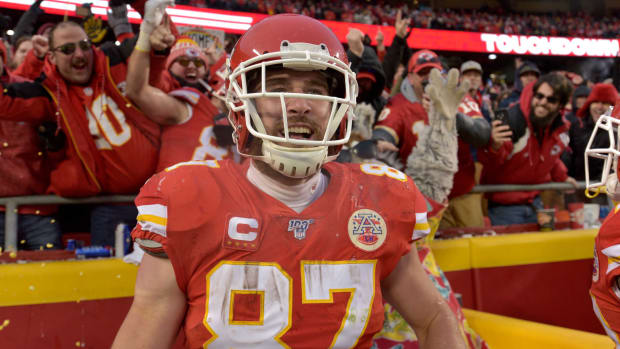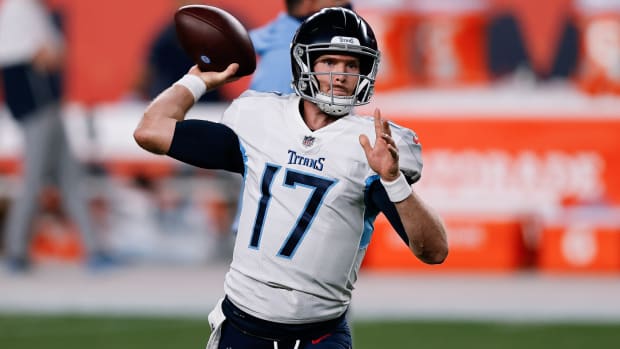New on Sports Illustrated: Fantasy Football Draft Strategies: First Six Picks Drafting 9th to 12th
Formulate your fantasy football plan of attack with draft strategies when selecting from the 9th to 12th positions.
To wrap up the
draft strategy series, we’re breaking down slots 9-12. This range has a lot of value at the first-round turn, but just like picks 1-4, you have to have a near-perfect draft because of the large gaps between your selections.Draft Pick Draft Strategies
Picks: 1 to 4 | Picks 5 to 8 | Picks 9 to 12
Picks 9 to 12 draft strategy breakdown

This is the point in the draft where you have the best shot at getting two RB1s. Take advantage of that. If you came away with a duo like Aaron Jones and Najee Harris in the first two rounds, you would be covered at the position, and when your third- and fourth-round picks come around, you can draft back-to-back receivers from a deep talent pool at the position. Beyond Jones and Harris, I like all of the backs my colleague Michael Fabiano has ranked in this range. Jonathan Taylor, Saquon Barkley (at this point, he's a value), and Joe Mixon are all between No. 9 and No. 17.

There are a few exceptions to grabbing two running backs here. If Travis Kelce falls to you at any of these picks late in the first, take him. He’s on a tight end tier of his own, and any investment in Kansas City’s offense is a good one. Speaking of the Chiefs, Tyreek Hill, 2020's second-highest scoring receiver, is another great pick at the end of the first round.
Getting into second-round receivers, Stefon Diggs is a good pick to lead the league in targets again, and DeAndre Hopkins was just behind him in that regard last season. They're both bets on volume and talent in pass-happy offenses. If you're drafting in this range, there's no good excuse not to have an RB1 on your team after the first two rounds pass. Even if you don't love Harris behind the Steelers' offensive line or Mixon with Joe Burrow's return slow-going, they're far superior to the backs you'll find when your third- and fourth-round picks come around.
I like the picks in this range a lot. I prefer to secure a running back in the first round and then go receiver in the second, but it depends on who falls to you. Great players are available here, and you get to select two of them in quick succession.
Drafting in rounds 3 and 4
Remember the warning to get an RB1 in the first round? If you didn't follow that advice, you would regret it when you finally draft again in the third. David Montgomery, Darrell Henderson, Mike Davis, and Myles Gaskin are not RB1 material, but that’s who’ll be available at this point. I like Montgomery as an RB2, a lot actually. But you’re in trouble if he’s your lead back.
The receivers available from picks 33-40 are all solid. Robert Woods, Amari Cooper, Tyler Lockett, and Diontae Johnson are potential targets here. You'll likely miss out on the last of the WR1s (Allen Robinson, CeeDee Lamb, Terry McLaurin) at the end of the second and early in the third. Because of the running back and receiver talent in the draft here, I like taking care of your RB1 and WR1 with your first two picks and getting your secondary option at each position in these rounds. Henderson and Johnson don't make for No. 1 guys at their positions, but if you paired Henderson with Jones and Diggs with Johnson, you have every reason to be pleased with the first four rounds of your draft.
Drafting in rounds 5 and 6
Bonus round! We only went through the first five rounds for the first two installments of the draft strategy series, but because of the way that picks 9-12 unfold, it made sense to add round six. This breaks with the quarterback logic I employed for those picking 1-8, but the anticipated run on quarterbacks between your sixth- and seventh-round choices makes drafting a quarterback in the fifth or sixth round worth it. If you wait until the seventh round, you'll be stuck with a low-end QB1.

Isaiah J. Downing-USA TODAY Sports
There’s nothing wrong with Ryan Tannehill. The Titans QB has been one of the NFL’s most efficient passers the last two seasons, but it’s better to have your choice of one of the top six or so available passers (Josh Allen, Kyler Murray, Dak Prescott, Aaron Rodgers, Russell Wilson, Justin Herbert) than watch helplessly as quarterbacks fly off the board.
With your non-QB pick in this range, I like the second-tier tight ends or grabbing a running back to start at flex. Fabiano has Mark Andrews, Kyle Pitts, and T.J. Hockensen ranked 55, 57, and 59. It's realistic for one of them to be there for you in the fifth. I'm not high on the receivers (besides Robby Anderson) projected to go in these two rounds for these positions. I prefer grabbing a third running back: Travis Etienne, Chase Edmonds, or Javonte Williams. Running backs are in high demand in fantasy every year. It's extremely valuable to have three starting-caliber RBs to plug in week-to-week. Injuries happen, bye weeks come around, and all of those players could potentially break out.
Takeaways from drafting from picks 9 to 12
This is the best range to pick from in the draft. You have RB1s still on the table in the second round and the first shot at elite receivers. It's always going to be difficult to sit on your hands for 23 straight selections if you happen to have the 12th pick, but the players who will be there for you at picks 12 and 13 are elite. Through six rounds, you should have a quarterback, both running backs and both receivers. After that, it's up to you to take one of the top-six tight ends or grab another running back to plug in at flex.
More Fantasy Football:








No comments